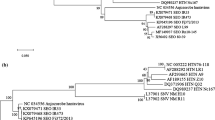Summary
Retrovirus infectivity is the result of a cooperative interaction of three structural genes,gag, pol, andenv. Since the L-cell endogenous retrovirus (LCV) lacks theenv gene translation product, our aim was to study the biological and molecular basis of its non-infectiousness. Fusion experiments between LCV and homologous or heterologous cells demonstrated that virus production could be obtained only after LCV artificial penetration in murine cells and that the new progeny was still noninfectious. Northern blot analysis and heteroduplex mapping of the genomic RNA revealed a 0.99 kb deletion including the 3′ region of thepol reading frame, the whole xenotropic and part of the ecotropic domain of theenv gene. The results suggest that the observed deletion is responsible for the absence of the gp 70 and the gp 15 E molecules in the virion and seems therefore to be the molecular basis for the non-infectiousness of this retrovirus.
Similar content being viewed by others
References
Bolognesi DP, Montelaro RC, Frank H, Schafer W (1978) Assembly of type C oncornaviruses: a model. Science 199: 183–186
Bosselman RA, van Straaten F, van Beveren C, Verma IM, Vogt M (1982) Analysis of theenv gene of a molecularly cloned and biologically active Moloney mink cell focus-forming proviral DNA. J Virol 44: 19–31
Chan HW, Bryan T, Moore JL, Staal SP, Rowe WP, Martin M (1980) Identification of ecotropic proviral sequence in inbred mouse strains with a cloned subgenomic DNA fragment. Proc Natl Acad Sci USA 77: 5779–5783
Chattopadhay SK, Lander MR, Rands E, Lowy DR (1980) The structure of murine leukemia virus DNA in mouse genomes. Proc Natl Acad Sci USA 77: 5774–5778
Chattopadhay SK, Lander MR, Gupta S, Rands E, Lowy DR (1981) Origin of mink cytopathic focus-forming (MCF) viruses: comparison with ecotropic and xenotropic murine leukemia virus genomes. Virology 113: 465–483
Chattopadhay SK, Cloyd MW, Linemayer DL, Llander MR, Rands E, Lowy DR (1982) Cellular origin and role of mink cell focus-forming viruses in murine thymic lymphomas. Nature 295: 25–31
Cloyd MW, Hartley JW, Rowe WP (1980) Lymphomagenicity of recombinant cell focus-inducing murine leukemia viruses. J Exp Med 151: 542–552
Dales S, Howatson AF (1961) Virus-like particles in association with L strain cells. Cancer Res 21: 193–197
Davis R, Simon M, Davidson N (1971) Electron microscope heteroduplex methods for mapping regions of base sequence homology in nucleic acids. Methods Enzymol 21: 413–428
De Giuli C, Kawai S, Dales S, Hanafusa H (1975) Absence of surface projections on some non infectious forms of RSV. Virology 66: 253–260
De Larco J, Todaro GJ (1976) Membrane receptors for murine leukemia viruses; characterization using the purified viral envelope glycoprotein gp 71. Cell 8: 365–371
Godson GN, Vapnek D (1973) A simple method of preparing large amounts of Φx 174 RFI supercoiled DNA. Biochim Biophys Acta 299: 516–520
Haas M, Patch V (1980) Cell-surface antigens associated with dualtropic and thymotropic murine leukemia viruses inducting thymic and nonthymic lymphomas. J Exp Med 151: 1321–1333
Herr W, Corbin V, Gilbert W (1982) Nucleotide sequence of the 3′ half of AKV. Nucleic Acids Res 10: 6931–6944
Herr W, Schwartz D, Gilbert W (1983) Isolation and mapping of cDNA hybridization probes specific for ecotropic and nonecotropic murine leukemia proviruses. Virology 125: 139–154
Junghans RP, Hu S, Knight CA, Davidson N (1977) Heteroduplex analysis of avian RNA tumor viruses. Proc Natl Acad Sci USA 74: 477–481
Koch W, Hunsmann G, Friedrich R (1983) Nucleotide sequence of the envelope gene of friend murine leukemia virus. J Virol 45: 1–9
Lehrach H, Diamond D, Wozney JM, Boedtker H (1977) RNA molecular weight determinations by gel electrophoresis under denaturating conditions, a critical reexamination. Biochemistry 16: 4743–4751
Lenz J, Crowther R, Straceski A, Haseltine W (1982) Nucleotide sequence of the AKVenv gene. J Virol 42: 519–529
Lerner TL, Hanafusa H (1984) DNA sequence of the Bryan high-titer strain of Rous sarcoma virus: extent ofenv deletion and possible genealogical relationship with other viral strains. J Virol 49: 549–556
Machida CA, Bestwick RK, Kabat D (1984) Reduced leukemogenicity caused by mutations in the membrane glycoprotein gene of Rauscher spleen focus-forming virus. J Virol 49: 394–402
Ogura H, Friis M (1975) Further evidence for the existence of a viral envelope protein defect in the Bryan high-titer strain of Rous Sarcoma Virus. J Virol 16: 443–446
Pontecorvo G (1975) Production of mammalian cell hybrids by means of polyethylene glicol treatment. Somatic Cell Genet 1: 397–400
Radaelli A, Righi M, Liboi E, De Giuli Morghen C (1984) Ultrastructural and biochemical evidence that the L 929 cell retrovirus lacks theenv gene translation product. J Gen Virol 65: 295–307
Rigby PWJ, Dieckmann M, Rhodes C, Berg P (1977) Labelling deoxyribonucleic acids to high specific activity in vitro by nick translation with DNA polymerase I. J Mol Biol 113: 237–251
Rohde W, Pauli G, Henning J, Friis RR (1978) Polyethylene glycol-mediated infection with avian sarcoma viruses. Arch Virol 58: 55–59
Ross J, Scolnick EM, Todaro GJ, Aaronson SA (1971) Separation of mouse cellular and mouse leukemia virus DNA polymerases. Nature (New Biol) 231: 163–167
Ruta M, Bestwick R, Machida C, Kabat D (1982) Loss of leukemogenicity caused by mutations in the membrane glycoprotein structural gene of Friend spleen focus-forming virus. Proc Natl Acad Sci USA 80: 4704–4708
Shinnick TM, Lerner RA, Sutcliffe JG (1981) Nucleotide sequence of Moloney murine leukemia virus. Nature 293: 543–548
Wolff L, Scolnick E, Ruscetti S (1983) Envelope gene of the Friend spleen focus-forming virus: deletion and insertions in 3′ gp 70/p 15E-encoding region have resulted in unique features in the primary structure of its protein product. Proc Natl Acad Sci USA 80: 4718–4722
Author information
Authors and Affiliations
Rights and permissions
About this article
Cite this article
De Giuli Morghen, C., Custode, P., Lavanga, E. et al. Biological and molecular analysis of LCV, an endogenous retrovirus with defectiveenv gene. Archives of Virology 102, 99–110 (1988). https://doi.org/10.1007/BF01315566
Received:
Accepted:
Issue Date:
DOI: https://doi.org/10.1007/BF01315566




